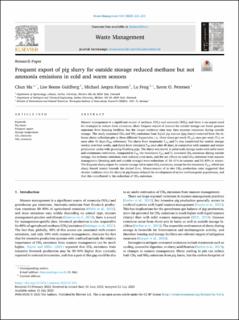| dc.description.abstract | Manure management is a significant source of methane (CH4) and ammonia (NH3), and there is an urgent need for strategies to reduce these emissions. More frequent export of manure for outside storage can lower gaseous emissions from housing facilities, but the longer residence time may then increase emissions during outside storage. This study examined CH4 and NH3 emissions from liquid pig manure (pig slurry) removed from the in-house slurry collection pits at three different frequencies, i.e., three times per week (T2.3), once per week (T7), or once after 40 days (T40, reference). The slurry from treatments T2.3 and T7 was transferred for outside storage weekly over four weeks, and slurry from treatment T40 once after 40 days, in connection with summer and winter production cycles with growing-finishing pigs. The slurry was stored in pilot-scale storage tanks with solid cover and continuous ventilation. Compared to T40, the treatments T2.3 and T7 increased CH4 emissions during outside storage, but in-house emissions were reduced even more, and the net effects on total CH4 emissions from manure management (housing unit and outside storage) were reductions of 18–41% in summer and 53–83% in winter. The frequent slurry export for outside storage led to more NH3 emissions, except for the treatment T2.3, which has slurry funnel inserts beneath the slatted floor. Measurements of in-vitro CH4 production rates suggested that shorter residence time for slurry in pig houses delayed the development of active methanogenic populations, and that this contributed to the reduction of CH4 emissions. | en_US |

